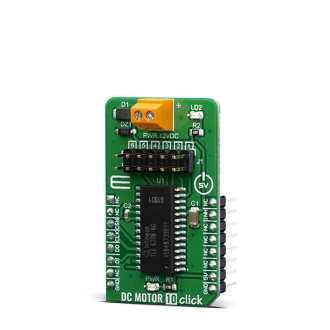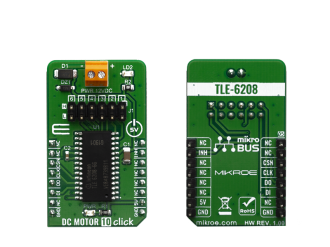
We strongly encourage users to use Package manager for sharing their code on Libstock website, because it boosts your efficiency and leaves the end user with no room for error. [more info]

Rating:
Author: MIKROE
Last Updated: 2019-12-09
Package Version: 1.0.0.0
mikroSDK Library: 1.0.0.0
Category: Brushed
Downloaded: 2758 times
Not followed.
License: MIT license
DC Motor 10 Click is a brushed DC motor driver with the current limiting and current sensing. It is based on the TLE 6208-6 G, an Hex-Half-Bridge / Double Six-Driver IC, optimized for motor driving applications.
Do you want to subscribe in order to receive notifications regarding "DC MOTOR 10" changes.
Do you want to unsubscribe in order to stop receiving notifications regarding "DC MOTOR 10" changes.
Do you want to report abuse regarding "DC MOTOR 10".


Library Description
The library covers all the necessary functions that enables the usage of the DC Motor 10 Click board. It initializes and defines the SPI bus driver and drivers that allow full control of the device to the user. It is possible to enable up to 6 dc motors in hlaf bridge, or 5 with full bridge.
Key functions:
void dcmotor10_resetStatusReg(); - Function is used to reset status register.void dcmotor10_enableChann1(); - Function is used to enable channel 1.void dcmotor10_sendCommand( uint16_t wrData ); - Function is used to send command.Examples description
The application is composed of three sections :
void applicationTask()
{
dcmotor10_sendCommand( _DCMOTOR10_ENABLE_1 | _DCMOTOR10_ENABLE_2
| _DCMOTOR10_ENABLE_3 );
Delay_ms( 5000 );
dcmotor10_enableChann1();
Delay_ms( 5000 );
dcmotor10_enableChann2();
Delay_ms( 5000 );
dcmotor10_enableChann3();
Delay_ms( 5000 );
dcmotor10_resetStatusReg();
Delay_ms( 1000 );
}
Other mikroE Libraries used in the example:
Additional notes and informations
Depending on the development board you are using, you may need USB UART click, USB UART 2 click or RS232 click to connect to your PC, for development systems with no UART to USB interface available on the board. The terminal available in all MikroElektronika compilers, or any other terminal application of your choice, can be used to read the message.